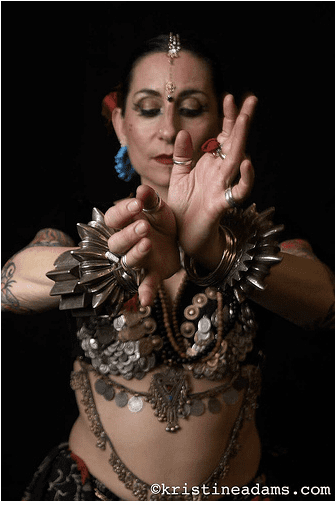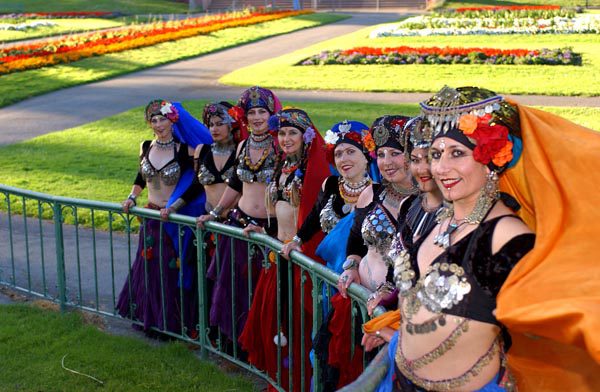What Is FatChanceBellyDance Style?
FatChanceBellyDance
From San Francisco Roots to a Worldwide Movement
FatChanceBellyDance Style (FCBD Style), also known as American Tribal Style® (ATS®), is a modern style of dance created by FatChanceBellyDance director, Carolena Nericcio.
In 1974, Carolena began belly dancing with Masha Archer and the San Francisco Classic Dance Troupe. Masha’s style was an eclectic blend of classic Egyptian, Folkloric and any other influence that she found enticing. Masha, a trained painter and sculptor, taught her dancers to create art through dance. In 1987, after the SF Classic Dance Troupe disbanded, Carolena began teaching in a small studio in the Noe Valley Ministry. Her only goal was to teach people to dance so she could have dance partners.
When the need for a name for the dance troupe arose, a friend suggested the playful rhyme FatChanceBellyDance, based on the silly question dancers often get from onlookers who think that beautiful, feminine belly dance is merely an exotic entertainment for their personal pleasure. In other words, the answer is: “Fat chance you can have a private show!” The name embodied the group’s unapologetic energy, humor, and feminine strength.

The Evolution of ATS® and FCBD Style
Being young and tattooed, Carolena attracted other young people living alternative lifestyles. The Modern Primitives movement was also underway. Tattoos and primitive styles of body adornment were the vogue. Carolena and her students performed at tattoo shows and conventions and became well known in the City by the Bay.
As Carolena and FatChanceBellyDance expanded horizons they received a mixed response. Some people loved the new style others abhorred its departure from tradition. Finally, the style was named “American Tribal Style® Belly Dance”, a name that distanced ATS® from classical beledi styles. The word “American” made it clear that ATS® was distinctly an American invention, not a traditional dance style. “Tribal Style” described the dancers working together as a group with a “tribal” look.
Back at the studio, Carolena’s new dance system was evolving.
Because of the casual nature of FCBD®’s performance opportunities, the dance was largely improvisational. There simply wasn’t a way, or a need, to choreograph because the dance space often changed at the last minute, and the dancers had to perform without rehearsal or any information about the performance space.
Duets, trios and quartets worked in set formations. If the stage was two-sided, or if the dance space was in the round, the dancers could flip the lead by facing the opposite direction. In other words, as long as the dancers stayed in formation, the group could face any direction and the lead could change, depending on the audience’s location. Carolena developed cues for each step or combination, usually an arm or head movement that could easily be seen. She found that because all steps began with a gesture to the right, dancers tended to angle to the left. This angle allowed following dancers to clearly see the lead dancer.
Cues and formations are the brilliance of ATS®. Often unnoticed because of the elaborate costumes, fancy steps, exciting music, and sheer beauty of women dancing together, formations and cues are the anchor of improvisational choreography. Even occasional formal choreography is created around the logic of the formations and cues.
What often captivates audiences—the rich costumes, the hypnotic zills, the flowing skirts, the collective energy—is only part of the magic. Beneath the surface lies a brilliant system of visual communication and mutual trust. Every movement is shared. Every step begins with a cue. Every dancer, whether leading or following, contributes to the unfolding tapestry.
The core concept remains in place: leader to the left, followers to the right. Watch for interaction among the dancers, who always have their attention trained on the lead position, looking for the cue for the next step. When the dancers face each other and make eye contact, the lead is neutral, falling to the dancer who presents the next cue. But don’t think too hard! Allow yourself to see the whole picture: women working together in cooperation; a group focused on presenting the dance as one entity.

A slide show presented by Carolena at Elevation, 2019. Video produced by Lazy Pickle Productions. Slideshow complied by Lisa Branner/Caldera Tribal.
Carolena’s vision continues to inspire dancers worldwide. Through classes, certification programs, workshops, and online learning, students can experience the power of FCBD Style in communities across the globe.
Whether you’re just discovering belly dance or ready to dive deeper into the FCBD Style format, you’re invited to join a movement that honors tradition, embraces innovation, and brings people together through the language of dance.

